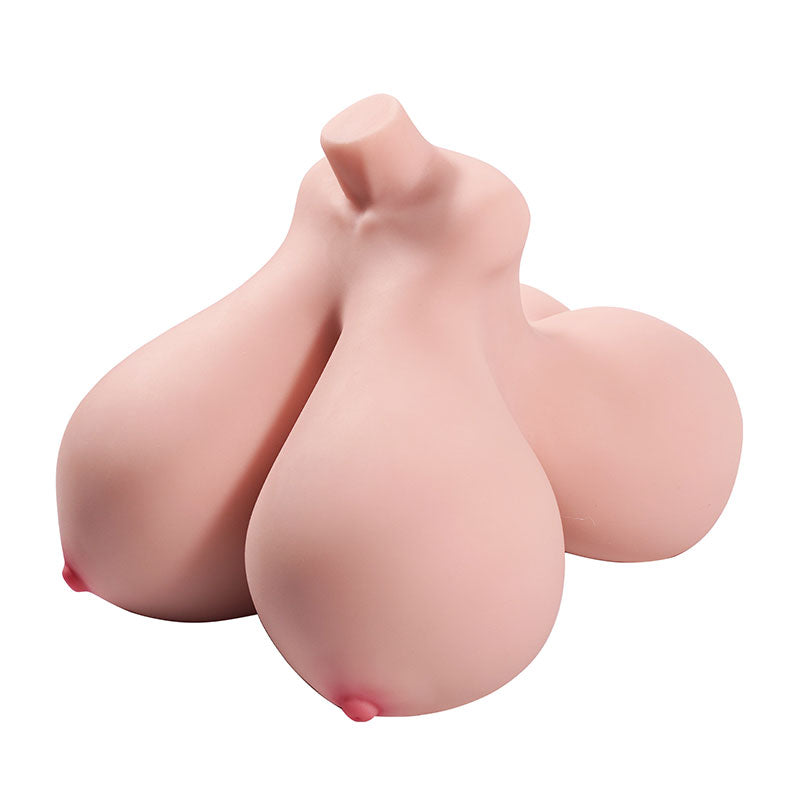The Ultimate Guide on How to Prepare for Anal Sex: Safety, Pleasure, and Communication
Table of Contents
1.The Foundational Pillars: Communication, Consent, and Anatomy
2.Physical Preparation: A Meticulous Guide to Hygiene and Comfort
3.The Science of Slick: An In-Depth Analysis of Personal Lubricants
4.A Framework for Comprehensive Risk Mitigation
5.Putting It All Together: Positions, Pacing, and Pleasure
6.Frequently Asked Questions (FAQ)
The Foundational Pillars: Communication, Consent, and Anatomy
When trying any new sexual activity, especially anal sex, it's crucial to build a foundation of respect, communication, and understanding of the body. These aren't just extra steps; they are essential for a safe, consensual, and enjoyable experience for everyone. Before getting physical, you need to establish emotional and psychological safety first.
The Primacy of Communication: Initiating the Conversation
Open and honest communication is the most important part of a good experience with anal sex. You should have this conversation long before you get into bed. This creates a pressure-free space where both of you can talk about your curiosities, desires, limits, and fears without being judged.
This talk isn't just a clinical requirement; it's a form of foreplay that builds intimacy and trust. When you share your expectations and listen to your partner, you create a strong emotional connection. This helps reduce anxiety and makes it easier for both partners to relax and feel respected, which greatly enhances the experience later on.

For effective communication:
·Find the Right Time: Talk in a private, comfortable place where you won't be distracted or rushed.
·Use "I" Statements: Express your feelings from your own perspective, like "I'm curious about trying..." or "I feel a bit nervous about..." This avoids putting pressure on your partner.
·Listen Actively: Pay close attention to your partner and ask questions to make sure you understand their feelings and boundaries.
·Discuss Specifics: Be clear about what anal sex means to each of you. It can include more than just penetration, such as oral-anal contact (rimming) or using fingers and toys. Knowing what you both are interested in helps manage expectations.
The Legal and Ethical Mandate of Enthusiastic Consent
Consent is an absolute requirement for any sexual activity, legally and ethically. For something as sensitive as anal sex, it's vital to understand what consent really means. It's not just a one-time "yes" but a continuous conversation that happens throughout the experience.

Good consent is Freely given, Knowing, and Enthusiastic.
·Freely Given: Consent must be given without any pressure, guilt, or threats.
·Knowing: Everyone involved must understand what sexual acts are being proposed. A person who is drunk, high, asleep, or unconscious cannot give consent.
·Enthusiastic: The best consent is an enthusiastic "yes," not just the lack of a "no." Silence does not mean someone agrees. Look for positive signs, both verbal and non-verbal, that show your partner is genuinely excited.
Consent can also be taken back at any time. If something becomes painful or uncomfortable, anyone has the right to stop immediately, and this must be respected. Consent is also specific; agreeing to one thing doesn't mean you agree to everything. For example, removing a condom without your partner's knowledge (stealthing) is a violation of consent.
A Clinical Understanding of Anal and Rectal Anatomy
Understanding some basic anatomy is important because it explains why certain safety steps are needed for anal sex. The anus and rectum are built differently than the vagina, and these differences require special preparation.

·Delicate Tissues: The lining of the rectum is thin and delicate. Unlike the vagina, it can tear easily from friction, causing pain and creating openings for bacteria and STIs. This is why using plenty of lubricant is essential.
·Lack of Natural Lubrication: The anus and rectum do not self-lubricate like the vagina does during arousal. Without adding lube, friction will almost certainly cause pain and damage.
·Anal Sphincters: The anus has two strong muscles called sphincters, which are naturally tight. For comfortable penetration, these muscles need to be completely relaxed. This happens with arousal, trust, and a slow, gentle approach.
·Presence of Bacteria: The rectum stores fecal matter, which contains bacteria like E. coli. This makes hygiene and using barriers like condoms very important to prevent spreading bacteria to other parts of the body, which could cause infections like UTIs.
Knowing this anatomy helps you understand that safety guidelines are logical, evidence-based practices designed to work with your body.
Physical Preparation: A Meticulous Guide to Hygiene and Comfort
Worrying about being clean is a very common source of anxiety when thinking about anal sex. These are valid concerns, but you can manage them with safe and practical hygiene steps. It's important to be careful, as some common cleaning methods can actually increase health risks if not done correctly.
Anal Cleansing Protocols: To Douche or Not to Douche?
Anal douching, or flushing the rectum with liquid, is a common practice but is not medically necessary. Many people do it to feel more confident and relaxed, which can improve the experience. Often, just washing the outside with soap and water is enough.

However, douching can have a downside. If done too often or improperly, it can irritate the rectal lining and strip away its protective mucus. This can make the tissue more fragile and increase the risk of tearing and STIs like HIV. So, if you choose to douche, think of it as a way to gain peace of mind without harming your body. It's best to limit douching to no more than once a day and only two or three times a week.
A Comparative Analysis of Anal Cleansing Methods
If you decide to douche, choosing the right tool is key to staying safe. The goal is a shallow cleanse of the rectum, not a deep cleaning of the colon.
|
Method |
Safety Profile |
Ease of Use |
Key Risk Factors |
Expert Recommendation |
|
Saline Enema Kit (e.g., Fleet) |
High |
High |
Low risk if used as directed. Make sure it's a saline-only solution, not a laxative. |
One of the safest options. The volume is pre-measured, and the nozzle is soft and lubricated. |
|
Anal Douche Bulb |
Moderate |
Moderate |
Risk of using too much water or pressure. Hard plastic nozzles can cause injury; silicone tips are better. |
A common and effective method. Use lukewarm water and gentle pressure. |
|
Water Bag Douche |
Low to Moderate |
Moderate |
Hard to control flow and pressure. The large volume increases the risk of over-douching. |
Use with caution. A bulb or kit with a controllable volume is a better choice. |
|
Shower Enema/Attachment |
Low |
Low |
High risk of internal burns from hot water and tissue damage from high pressure. |
Generally not recommended. If used, never insert the nozzle; just hold it to the opening. |
Always use lukewarm water for douching. Water that is too hot can cause burns, and cold water can cause cramps. A saline solution is gentler than plain tap water. After douching, wait about 30-60 minutes to make sure all the water is out before you have sex.
Pre-Sex Diet and Other Hygiene Considerations
Other habits can also help with comfort and safety.

·Diet: A high-fiber diet helps keep you regular, which naturally keeps the rectum clearer. It's also a good idea to avoid large meals a few hours before anal sex, as eating can stimulate your digestive system.
·Personal Grooming: If you plan to use fingers, make sure your fingernails are trimmed short and filed smooth to avoid scratching the delicate skin of the anus and rectum.
·Bowel Movement: Going to the bathroom 30-60 minutes before sex can help empty the rectum and reduce any anxiety about messiness.
The Science of Slick: An In-Depth Analysis of Personal Lubricants
Personal lubricant is the one tool you absolutely must have for safe and pleasurable anal sex. It's not just for comfort; it's a key safety measure that protects your body from injury and lowers the risk of infection.
Why Lubricant is Non-Negotiable for Anal Sex

As mentioned, the rectum doesn't make its own lube and has very delicate tissue. Lubricant solves both of these issues by creating a slick barrier that reduces friction. This helps prevent pain, reduces the chance of tears in the rectal lining, and lowers the risk of STI transmission by minimizing entry points for germs. Not using enough lube is a common mistake, so don't be shy. For anal sex, there's no such thing as too much lube. Apply it generously and reapply it whenever you need to.
Deconstructing Lubricant Types: A Chemical and Practical Breakdown
The type of lube you choose depends on the condoms and sex toys you use. It's important to understand how different lubes work to make a safe choice.
·Water-Based Lubricants: These are a great all-around choice. They are safe with all condoms and sex toys. The main downside is that they can dry out and may need to be reapplied during long sessions.

·Silicone-Based Lubricants: These are a favorite for anal sex because they are very slick, long-lasting, and waterproof. They are safe with latex and polyurethane condoms. However, they should not be used with silicone sex toys, as the lube can damage the toy over time.

·Oil-Based Lubricants: This includes things like coconut oil and Vaseline. They are very slick, but they have a major safety warning: oil-based lubes destroy latex condoms, making them break easily. They should never be used with latex condoms. They can also be messy and may stain fabrics.

·Hybrid Lubricants: These are a mix of water and silicone. They last longer than water-based lubes and are easier to clean than silicone-based ones. Check the label to see if they are safe with silicone toys.

Lubricant Selection Matrix and Debunking DIY Myths
This chart can help you choose the right lube.
|
Lubricant Type |
Latex Condom Safe? |
Polyurethane Condom Safe? |
Silicone Toy Safe? |
Key Features |
Best For |
|
Water-Based |
Yes |
Yes |
Yes |
Easy to clean, hypoallergenic, dries out faster. |
Universal use, beginners, use with all types of toys, quick sessions. |
|
Silicone-Based |
Yes |
Yes |
No |
Very long-lasting, waterproof, can stain fabric. |
Long sessions, shower/water play, when not using silicone toys. |
|
Oil-Based |
No |
Check Label |
Yes (for non-latex toys) |
Very long-lasting, natural options (coconut oil), breaks down latex. |
Use without latex condoms only, external massage. |
|
Hybrid (Water/Silicone) |
Yes |
Yes |
Check Label |
Longer-lasting than water-based, easier to clean than silicone. |
A balance of longevity and ease of cleaning. |
Avoid using things that aren't meant to be personal lubricants. Saliva dries quickly and has bacteria. Lotions and creams can have irritating chemicals, and oil-based products like Vaseline will damage latex condoms.
A Framework for Comprehensive Risk Mitigation
Anal sex can be very pleasurable and intimate, but it does carry a higher risk of spreading some STIs. You can manage this risk with a modern approach to sexual health that includes safe behaviors, medical options, and regular check-ups.
Understanding the Heightened Risk of STI Transmission
The higher risk of STIs with receptive anal sex is due to the rectum's anatomy. The single layer of cells lining the rectum is more fragile than the tissue in the vagina. This means that even with lube, tiny tears can happen, creating a direct path for viruses and bacteria to enter the bloodstream. This is why the risk of getting infections like HIV is much higher with receptive anal sex. HPV, which can cause anal warts and cancer, is also easily spread through anal contact.
The Modern Toolkit for Prevention: Barriers and Biomedical Interventions
Modern sexual health is about more than just condoms. It's a holistic strategy with multiple layers of protection.
·Barrier Methods: These are your first line of defense.
(1) Condoms: Using a new latex or polyurethane condom for any penetrative anal sex is one of the best ways to reduce the risk of most STIs. Always use a new condom when switching from anal to vaginal or oral play.

(2) Dental Dams: For oral-anal sex (rimming), a dental dam can be used as a barrier to prevent the spread of STIs and bacteria.

·Biomedical Interventions: These are medical strategies to prevent infection.
(1) PrEP (Pre-Exposure Prophylaxis): PrEP is a daily pill that is about 99% effective at preventing HIV from sex when taken as prescribed. It's a great tool for people at higher risk of HIV.
(2) HPV Vaccination: The HPV vaccine is highly effective at protecting against the types of HPV that cause most anal and other cancers, as well as genital warts. It's recommended for people up to age 26, and sometimes up to age 45 after talking with a doctor.
This approach combines behavior (barriers), medicine (PrEP, vaccines), and regular health check-ups for complete sexual health management.
The Importance of STI Screening and Partner Health History
Regular STI testing is a key part of being sexually responsible. Talking openly with partners about your sexual health history and testing status shows mutual care and respect. The CDC's "5Ps" can help you have these conversations with your doctor :

1.Partners: Number and gender of your partners.
2.Practices: Types of sex you have (oral, vaginal, anal).
3.Protection: How often you use condoms or other barriers.
4.Past History: Any previous STIs.
5.Pregnancy Intention: Any plans related to pregnancy.
Being ready to talk about these topics helps your doctor give you the right advice and testing.
Putting It All Together: Positions, Pacing, and Pleasure
Once you've covered communication, hygiene, and safety, you can focus on the act itself. For a good experience, especially for beginners, the most important things are relaxation, patience, and making sure the receiving partner is comfortable.
The Art of Relaxation and Gradual Acclimatization
The anal sphincter muscles need to be relaxed for comfortable entry. This is both a physical and mental process.
·Arousal and Foreplay: Plenty of foreplay is key. When the receiving partner is very aroused and feels safe, their body will relax naturally.
·Start Slow: Begin with gentle external touch and massage before trying to insert anything.
·Gradual Dilation: Using a well-lubricated finger is a great way to start. The receiving partner can control the pace, allowing their muscles to get used to the feeling. You can then move to two fingers or a small beginner's sex toy to help the body prepare for a penis.
·Toy Safety: Any object you insert into the anus must have a flared base. The rectum can create a vacuum effect during orgasm, which can pull a toy without a flared base inside the body. This is a medical emergency that may require surgery to remove.
An Introduction to Anal Toys for Preparation
Anal toys are designed for safe and gradual training.
·Butt Plugs: These are great for getting used to the feeling of fullness. A beginner's plug should be made of body-safe silicone, be small, and have a flared base. The flared base is a critical safety feature that prevents the toy from going all the way inside, which would require medical help to remove. Start by wearing a plug for short periods (10-15 minutes) to let your muscles get used to it.
·Anal Dilators: These kits come with a set of plugs in different sizes. You start with the smallest one and, over time, work your way up to larger sizes. This is a patient method that gives you full control over stretching and relaxing the sphincter muscles.
Remember, always use a lot of lubricant with any toy, and if you feel sharp pain, stop. This journey is about your comfort and pleasure.
A Note on Inclusive Pleasure and Health
Sexual health and pleasure are for everyone, no matter their race, gender, or sexual orientation. A good guide to sexual wellness must embrace this diversity. The advice on communication, safety, and preparation in this article applies to all bodies wanting to explore anal sex safely.
In sexual media, terms like ebony anal often come from porn categories that can create stereotypes. It is better to move away from fetishizing and toward a conversation about inclusive health. Due to systemic issues, Black communities have faced disparities in sexual health education. Affirming that sexual pleasure is a healthy part of life for everyone is a step toward health equity. The goal is to ensure every person feels respected and has the knowledge to make confident choices about their body and pleasure.
Frequently Asked Questions (FAQ)
1. Will anal sex permanently stretch my anus or affect my ability to control bowel movements? No, this is a common myth. The anal sphincter is a very elastic muscle that is designed to stretch and then return to its normal size. If you practice anal sex safely with plenty of relaxation and lube, it won't cause permanent stretching or problems with bowel control.
2. Is it normal to bleed a little after anal sex? A small amount of bright red blood can happen, especially for beginners or without enough lube. It's usually a sign of a tiny tear from friction. If this happens, take a break from anal play to let it heal. However, if you have heavy or dark-colored bleeding, or bleeding with severe pain, you should see a doctor right away.
3. Can you get pregnant from anal sex? No, you can't get pregnant directly from anal sex. However, pregnancy can happen if semen gets near the vaginal opening, as sperm can travel into the vagina.
4. How can I make anal sex more pleasurable and less painful? Pleasure comes from a mix of things. Good communication and trust are first. Second, make sure the receiving partner is fully aroused and relaxed. Third, use a lot of high-quality lube and reapply it often. Fourth, go slow, starting with external touch before moving to fingers or small toys. Finally, listen to your body and stop if you feel sharp pain. For many, pleasure comes from the feeling of fullness and the stimulation of internal nerves, like the prostate.
5. What's the connection between anal sex, HPV, and anal cancer? Receptive anal sex is the main risk factor for getting anal HPV. HPV is a very common STI. While most infections clear up on their own, some high-risk types can cause anal cancer if they persist. Using condoms can lower the risk of spreading HPV, and the HPV vaccine is a very effective way to prevent the types of HPV that are most likely to cause cancer.
References
Cleveland Clinic. (n.d.). Dental dam. Retrieved July 15, 2025, from https://my.clevelandclinic.org/health/drugs/22887-dental-dam
Dummies. (2016, March 26). How to have safe anal sex. https://www.dummies.com/article/body-mind-spirit/relationships-family/sex-gender/how-to-have-safe-anal-sex-190734/
Flo. (n.d.). Is anal sex safe? A guide to healthy anal play. Retrieved July 15, 2025, from https://flo.health/menstrual-cycle/sex/sexual-health/is-anal-sex-safe
Healthline. (2023, July 21). Anal sex safety: Risks, precautions, and best practices. https://www.healthline.com/health/healthy-sex/anal-sex-safety
Healthline. (2025, January 27). How to use an anal douche for a deeper clean. https://www.healthline.com/health/anal-douche
Mayo Clinic Staff. (n.d.). Anal cancer. Retrieved July 15, 2025, from https://www.mayoclinic.org/diseases-conditions/anal-cancer/symptoms-causes/syc-20354140
Medical News Today. (n.d.). How to talk to a doctor about sexual health. Retrieved July 15, 2025, from https://www.medicalnewstoday.com/articles/how-to-talk-to-doctor-about-sexual-health
NHS. (n.d.). How and when to take Pre-Exposure Prophylaxis (PrEP). Retrieved July 15, 2025, from https://www.nhs.uk/medicines/pre-exposure-prophylaxis-prep/how-and-when-to-take-pre-exposure-prophylaxis-prep/
Planned Parenthood. (n.d.). What do I need to know about anal sex? Retrieved July 15, 2025, from https://www.plannedparenthood.org/blog/what-do-i-need-to-know-about-anal-sex
Student Health and Counseling Services. (n.d.). Sexual communication. UC Davis. Retrieved July 15, 2025, from https://shcs.ucdavis.edu/health-topic/sexual-communication
WebMD. (n.d.). How to have anal sex for the first time. Retrieved July 15, 2025, from https://www.webmd.com/sex/how-to-have-anal-sex-first-time
World Health Organization. (n.d.). Sexually transmitted infections (STIs). Retrieved July 15, 2025, from https://www.who.int/news-room/fact-sheets/detail/sexually-transmitted-infections-(stis)
Wikipedia contributors. (n.d.-d). Douche. In Wikipedia. Retrieved July 11, 2025, from https://en.wikipedia.org/wiki/Douche
Wikipedia contributors. (n.d.-e). Anal sex. In Wikipedia. Retrieved July 11, 2025, from https://en.wikipedia.org/wiki/Anal_sex
Zaliznyak, M., Walton, A. B., Stelmar, J., Isaacson, D., Gaither, T. W., Knudson, G., & Garcia, M. M. (2023). Anal sex practices and rectal erogenous zone maps among men and transgender women. Sexual Medicine, 11(4), qfad051. https://doi.org/10.1093/sexmed/qfad051




















